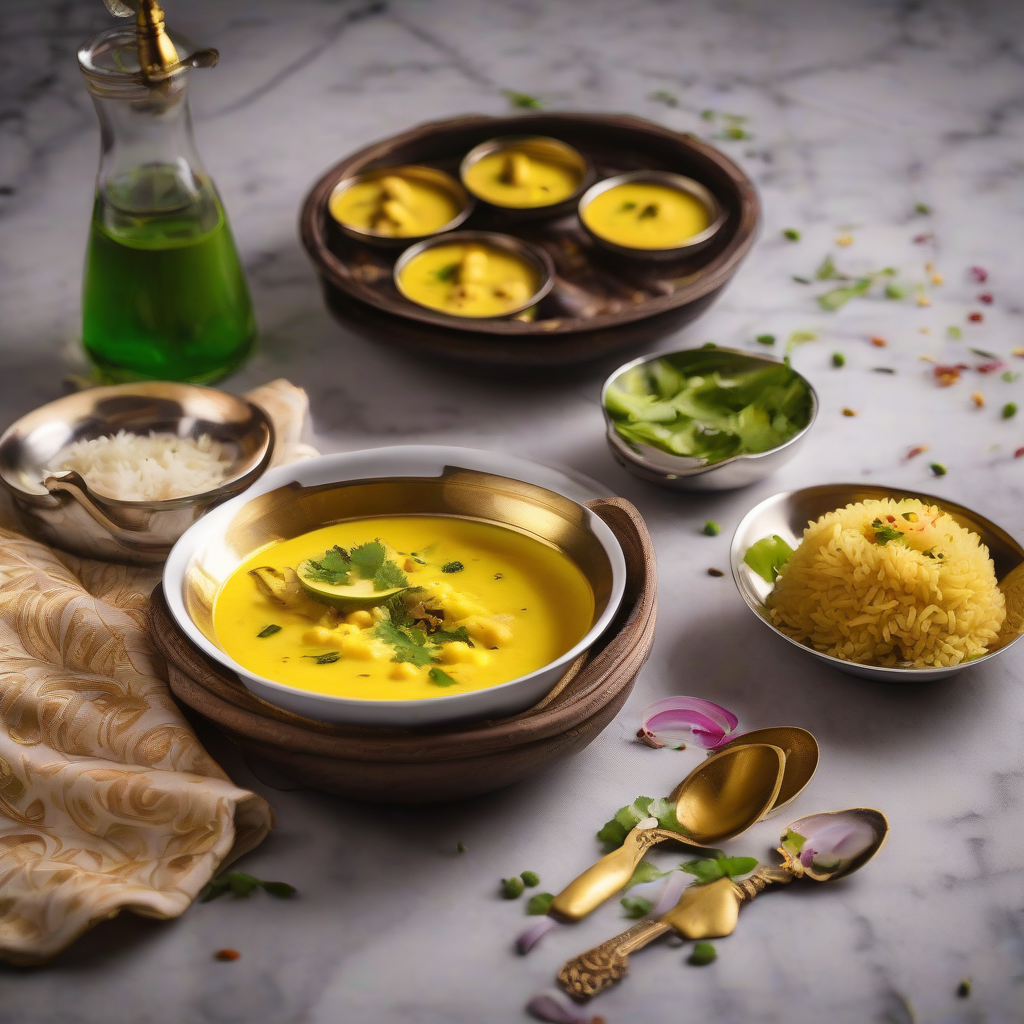Kadhi Chawal: Dil Maange More!
Namaste and Sat Sri Akal, my foodie friends! Chef Curry Do’pyaza here, back in your kitchens with a dish that’s as comforting as a warm hug on a chilly day: Kadhi Chawal!
For my Punjabi and North Indian friends, this dish needs no introduction. But for those of you who are new to the magic of Indian cuisine, get ready for a delightful experience! Kadhi Chawal isn’t just food; it’s a feeling.
When do we whip up this golden goodness?
Kadhi Chawal is a versatile dish, enjoyed throughout the year. But it truly shines during the monsoon season when a bowl of warm, tangy Kadhi Chawal is pure bliss. We often make it during festivals like Lohri and Baisakhi in Punjab, and it’s a staple in many North Indian homes for lunch or a light dinner. It’s also a common dish during weddings and other festive occasions.
A Little Trip Down Memory Lane
The origins of Kadhi are a bit hazy, like the smoke from my tandoor on a busy night! But it’s believed to have originated in Rajasthan. Over time, it traveled across North India, with each region adding its own special touch. The Punjabi Kadhi, which we’re making today, is known for its thick, creamy texture and the addition of pakoras (fritters).
Let’s Get Cooking!
This recipe is so easy, even your dadi (grandmother) would approve!
Preparation Time: 15 minutes
Cooking Time: 30 minutes
Ingredients You’ll Need:
- For the Kadhi:
- Besan (Gram Flour): 1/2 cup
- Dahi (Yogurt): 2 cups, whisked smooth
- Adrak-Lahsun Paste (Ginger-Garlic Paste): 1 teaspoon
- Haldi Powder (Turmeric Powder): 1/2 teaspoon
- Lal Mirch Powder (Red Chili Powder): 1/2 teaspoon (adjust to your spice level)
- Dhaniya Powder (Coriander Powder): 1 teaspoon
- Methi Dana (Fenugreek Seeds): 1/4 teaspoon
- Rai (Mustard Seeds): 1/2 teaspoon
- Jeera (Cumin Seeds): 1/2 teaspoon
- Hing (Asafoetida): A pinch
- Curry Patta (Curry Leaves): 8-10
- Hara Dhaniya (Fresh Coriander Leaves): For garnish
- Tel (Oil): 2 tablespoons
- Namak (Salt): To taste
- For the Pakoras (Optional, but highly recommended!):
- Besan (Gram Flour): 1/2 cup
- Pyaaz (Onion): 1 medium, finely chopped
- Hari Mirch (Green Chili): 1, finely chopped
- Hara Dhaniya (Fresh Coriander Leaves): 2 tablespoons, chopped
- Lal Mirch Powder (Red Chili Powder): 1/4 teaspoon
- Haldi Powder (Turmeric Powder): A pinch
- Namak (Salt): To taste
- Tel (Oil): For frying
- For Serving:
- Cooked Basmati Rice
Step-by-Step Instructions:
- Get the Kadhi Base Ready: In a large bowl, whisk together the besan and dahi until smooth. Add about 4 cups of water and whisk again. Make sure there are no lumps!
- Temper the Spices: Heat oil in a large pot or kadai (wok) over medium heat. Add methi dana, rai, and jeera. Let them splutter. Then, add hing and curry patta. Be careful, it might pop!
- Sauté the Aromatics: Add the adrak-lahsun paste and sauté for a minute until fragrant.
- Add the Powders: Add haldi powder, lal mirch powder, and dhaniya powder. Sauté for another 30 seconds, being careful not to burn the spices.
- Pour in the Kadhi Mixture: Slowly pour the besan-dahi mixture into the pot, stirring constantly to prevent lumps from forming.
- Simmer and Stir: Bring the Kadhi to a boil, then reduce the heat to low and simmer for at least 20-25 minutes, stirring occasionally. This is crucial for the besan to cook properly and the Kadhi to thicken.
- Make the Pakoras (While the Kadhi Simmers): In a bowl, mix together all the pakora ingredients with a little water to form a thick batter.
- Fry the Pakoras: Heat oil in a kadai or deep fryer. Drop spoonfuls of the batter into the hot oil and fry until golden brown and crispy. Drain on paper towels.
- Add Pakoras to Kadhi: Once the Kadhi has thickened to your liking, add the pakoras and simmer for another 5 minutes.
- Season and Garnish: Add namak to taste. Garnish with fresh hara dhaniya.
Tips for the Best Kadhi:
- Whisk, Whisk, Whisk: Whisking the dahi and besan well is key to a smooth Kadhi.
- Low and Slow: Simmering the Kadhi on low heat allows the flavors to meld together beautifully.
- Don’t Skip the Tempering: The tempering (adding spices to hot oil) is what gives Kadhi its signature flavor.
- Fresh is Best: Use fresh dahi for the best flavor.
Kadhi Your Way: Cooking Variations
- Gas Stove: Follow the instructions above using a heavy-bottomed pot.
- Induction Stove: Use the same method as the gas stove, adjusting the heat levels accordingly.
- Pressure Cooker: Not recommended as it can easily burn.
- Oven: Not recommended for this recipe.
- Microwave: Not recommended for this recipe.
- Air Fryer: You can air fry the pakoras at 350°F (175°C) for 10-12 minutes, flipping halfway through.
- Slow Cooker/Crockpot: Combine all Kadhi ingredients in the slow cooker and cook on low for 6-8 hours or on high for 3-4 hours. Add the pakoras in the last 30 minutes.
Nutritional Information (Approximate, per serving):
- Calories: 350-400
- Protein: 15-20g
- Carbohydrates: 40-45g
- Fat: 15-20g
Serving Suggestions:
Serve hot Kadhi Chawal with a dollop of ghee (clarified butter) on top. It pairs perfectly with a side of papad (poppadums) and a spicy pickle. Some people also enjoy it with a side of aloo gobi (potato and cauliflower curry).
Time to Get Cooking!
Now that you have my foolproof recipe, it’s time to roll up your sleeves and get cooking! This Kadhi Chawal is guaranteed to bring a smile to your face and warm your soul. Try this delicious recipe at home and share it with your friends and family. They will surely love it!
Until next time, happy cooking!
Your friend,
Chef Curry Do’pyaza!
